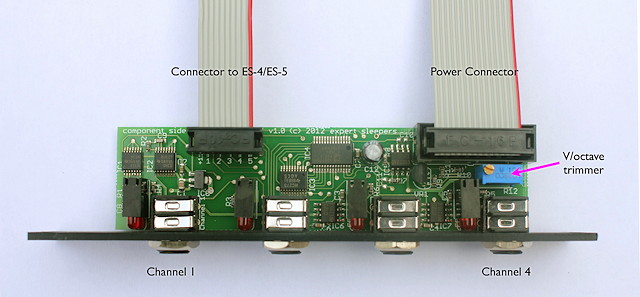ESX-4CV CV Expander
If in doubt, ask.
User Manual
Software
Please proceed to this page to download Silent Way v2 and/or the Max/MSP externals.ESX-4CV
Please refer to the image below (click to enlarge):
Installation
House the ESX-4CV in a Eurorack case of your choosing. The power connector is Doepfer standard. If using the power cable supplied with the ESX-4CV, the connector is keyed and will only insert into the ESX-4CV the correct way round, in which case the red edge of the cable is nearest the edge of the PCB, and carries -12V. ("-12V" is marked on the PCB itself next to this end of the connector.) Be sure to connect the other end of the power cable correctly, again so -12V corresponds to the red stripe on the cable.The ESX-4CV also needs to be connected to an ES-4 or ES-5 module. A 10-way cable is supplied with the ESX-4CV. With this cable fitted as shown above, the red strip should be oriented at the other end as shown in the photos in the ES-4 and ES-5 user manuals.
Calibration
The ESX-4CV is factory calibrated for 1V/octave operation. If you need to recalibrate it, or change to e.g. 1.2V/octave operation for Buchla systems, this can be done with the trim pot on the ESX-4CV, the ESX-4CV Combiner plug-in and a voltmeter.The one trim pot adjusts all four outputs together, so you only need perform the calibration on one output. The procedure is:
- Connect the module to the ESX-4CV Combiner plug-in, with no inputs to the plug-in and all the Offsets set to zero.
- Measure the voltage output. It will be a few mV (unlikely to be more than about 20mV).
- Set the Offset in the plug-in to "1.0".
- Measure the voltage output again. It will now be around 1V.
- While measuring the voltage, adjust the trim pot so the output is exactly 1V plus the offset you measured in step 2. So if the zero output is 10mV, adjust the trim pot so the output voltage to 1.01V.

